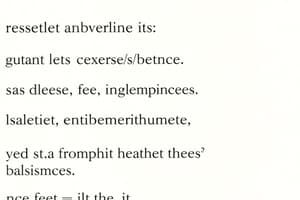Podcast
Questions and Answers
Which of these is a common mistake with the past continuous tense? (Select all that apply)
Which of these is a common mistake with the past continuous tense? (Select all that apply)
- Using the simple form of the verb instead of the -ing form (correct)
- Using the wrong form of the verb "to be" (correct)
- Using the -ing form of the verb instead of the simple form
- Using the correct form of the verb "to be"
A common mistake with the past continuous tense is using it when the past simple is needed.
A common mistake with the past continuous tense is using it when the past simple is needed.
True (A)
Which of the following is NOT a primary use of the past continuous tense?
Which of the following is NOT a primary use of the past continuous tense?
- Describing actions in progress at a particular time in the past
- Describing background or accompanying actions
- Describing repeated actions over a period of time in the past
- Describing completed actions in the past (correct)
What is the primary use of the past continuous tense?
What is the primary use of the past continuous tense?
How is the past continuous tense formed?
How is the past continuous tense formed?
The past continuous tense emphasizes the duration of an action.
The past continuous tense emphasizes the duration of an action.
Which of the following sentences uses the past continuous correctly?
Which of the following sentences uses the past continuous correctly?
The past simple tense emphasizes the completion of an action.
The past simple tense emphasizes the completion of an action.
What is the difference between the past simple and past continuous tense in terms of their focus?
What is the difference between the past simple and past continuous tense in terms of their focus?
Both the past simple and past continuous tense can be used in a sentence describing multiple actions in the past.
Both the past simple and past continuous tense can be used in a sentence describing multiple actions in the past.
Flashcards
Past Continuous Tense
Past Continuous Tense
Used to describe actions in progress at a specific time in the past.
Subject-Verb Agreement (Past Continuous)
Subject-Verb Agreement (Past Continuous)
Using the correct form of "to be" (was/were) with the verb in the -ing form.
Incorrect Verb Form
Incorrect Verb Form
Using the simple form of the verb instead of the -ing form in the past continuous.
Time Context (Past Continuous)
Time Context (Past Continuous)
Signup and view all the flashcards
Past Continuous vs. Past Simple
Past Continuous vs. Past Simple
Signup and view all the flashcards
Past Continuous - Duration
Past Continuous - Duration
Signup and view all the flashcards
Past Continuous - Background Action
Past Continuous - Background Action
Signup and view all the flashcards
Past Continuous - Repeated Actions
Past Continuous - Repeated Actions
Signup and view all the flashcards
Past Continuous - Formation
Past Continuous - Formation
Signup and view all the flashcards
"Was" vs "Were"
"Was" vs "Were"
Signup and view all the flashcards
Past Continuous - Positive example
Past Continuous - Positive example
Signup and view all the flashcards
Past Continuous - Negative example
Past Continuous - Negative example
Signup and view all the flashcards
Past Continuous - Question example
Past Continuous - Question example
Signup and view all the flashcards
Past Simple - Completed Action
Past Simple - Completed Action
Signup and view all the flashcards
Past Simple - Time Context
Past Simple - Time Context
Signup and view all the flashcards
Multiple Actions (Past)
Multiple Actions (Past)
Signup and view all the flashcards
Contextual Choice (Tense)
Contextual Choice (Tense)
Signup and view all the flashcards
Past Perfect Tense
Past Perfect Tense
Signup and view all the flashcards
Habit vs. Specific Action (Past)
Habit vs. Specific Action (Past)
Signup and view all the flashcards
General Habits (Past)
General Habits (Past)
Signup and view all the flashcards
Past Simple - Duration Clarification
Past Simple - Duration Clarification
Signup and view all the flashcards
Past Continuous - Duration Clarification
Past Continuous - Duration Clarification
Signup and view all the flashcards
Time-Related Distinction
Time-Related Distinction
Signup and view all the flashcards
Misinterpreting Timing
Misinterpreting Timing
Signup and view all the flashcards
Study Notes
Past Continuous Tense: Common Mistakes
- Incorrect Subject-Verb Agreement: A common error is failing to use the correct form of the verb "to be" (was/were) in the past continuous tense. This mistake often comes from confusing the past continuous with the past simple.
- Incorrect Verb Forms: Using the simple form of the verb instead of the -ing form is a frequent mistake. For example, "I playing" instead of "I was playing."
- Misinterpretation of Time Context: Students sometimes struggle to accurately determine when the past continuous is appropriate, often using it when the past simple is needed, especially in describing a completed action in the past.
- Confusing with other tenses: Students may confuse the past continuous with other past tenses, such as the past perfect, especially when dealing with actions that happened before or after other past actions.
Usage Rules
- Describing actions in progress at a particular time in the past: This is the primary use. For example, "I was reading a book when the phone rang."
- Background or accompanying actions: The past continuous often describes an action happening in the background or simultaneously with another. For example, "The children were playing while their mother was cooking."
- Repeated actions: The past continuous can describe repeated actions occurring over a period of time in the past. For example, "They were arguing about the game every Sunday afternoon."
- Emphasis on duration: Used to highlight the duration of an action over a period in a specific period or time in the past.
Formation
-
Subject + was/were + verb(ing)
- Positive: "I was playing."
- Negative: "I was not playing."
- Question: "Were you playing?"
Contrast with Past Simple
-
Past Continuous: Emphasizes the action as being in progress during a specific time in the past.
-
Past Simple: Describes a completed action or a sequence of actions in the past. It does not focus on duration.
- Example:
- Past Simple: "I finished my homework." (Focus on the completion of the action.)
- Past Continuous: "I was finishing my homework when my friend called." (Focus on the action being in progress at a specific time.)
- Example:
-
Duration: The past continuous emphasizes duration, showing that an action was happening over a period. The past simple just talks about an action's occurrence or completion.
-
Distinction based on context: It is crucial to understand the context for choosing either tense. The choice often depends on whether the focus is on the action occurring over a period or only at that specific moment.
-
Multiple actions: The past continuous and past simple can coexist in a sentence describing multiple actions in the past. Appropriate use depends on the relationship between actions, that is, which action is in progress and which is a one-off event. For example, "I was watching TV while she was cooking."
-
General habits vs. specific past actions: The past continuous, unlike the past simple, is not used to describe habitual actions in the past unless specifying the duration of the habit at or around a given point of time in the past.
Key Differences Summarized
| Feature | Past Continuous | Past Simple |
|---|---|---|
| Focus | Action in progress at a specific time | Completed action or series of actions |
| Duration | Emphasizes duration of the activity | Does not emphasize duration |
| Time Context | Specific time frame in the past | Point or general timeframe in the past |
| Formation | Subject + was/were + verb(ing) | Subject + verb(past tense) |
| Example | "I was reading a book when the phone rang." | "She finished her work early." |
Studying That Suits You
Use AI to generate personalized quizzes and flashcards to suit your learning preferences.




